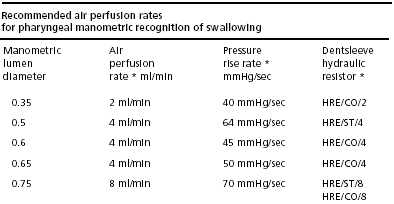Background
| |
Pharyngeal manometry is useful for
monitoring of swallowing, but pharyngeal water infusion
can cause irritation and so swallowing, as well as have
effects on oesophageal sphincter pressure.
|
| |
Dentsleeve
has developed the use of air as a perfusate for pharyngeal
manometric channels used for monitoring of swallowing.
|
| |
Dentsleeve
MK II and MK III manometric perfusion pumps provide for
one air perfusion circuit. The information in this section
relates primarily to Dentsleeve
manometric infusion pumps.
|
| |
Air perfusion rate can be controlled
with the same type of hydraulic resistor as is used for
water perfusion but this needs to have a high resistance
to flow or the air flow rate will be excessive.
|
| |
For a particular hydraulic
resistor, air flow rates are 100 times its water flow
rate at the same driving pressure.
|
| |
Air perfusion is especially useful
for monitoring of swallowing in neonates and small children
in whom the possibility of reflex stimulation and aspiration
of infused water is especially high.
|
| |
The air perfusion channel of Dentsleeve
Mark II and III pumps is supplied with compressed air
via a sidearm from the regulated pressure supply to the
perfusate reservoir, which is normally set to 15 psi or
100 kpa. |
|
 |
Performance
data
The diameter of the manometric channel influences the pressure
rise rate achieved with air perfusion, but the volume of the
pressure transducer chamber is the most important factor. The
smaller the volume the better.
Pressure transducer chamber volumes can vary widely amongst
different transducers, but nearly all modern pressure transducers
are acceptable.
Pressure rise rates with gas perfusion are summarised in the
table below. More detail is given for Dentsleeve
manometric extrusions in the performance data for each extrusion
(see Section 2, Manometric extrusions, pages 4-16).
Pressure rise rates sufficient for adequate swallow monitoring
are usually achieved with gas infusion rates of from 2-8
ml/min dependent on the diameter of the manometric channel,
its length and pressure transducer design.
Accordingly, Dentsleeve hydraulic
resistors with a high resistance value are required, ranging
from an HRE/ST/2 or HRE/CO/2 resistor (2 ml/min) to an HRE/ST/8
or HRE/CO/8 resistor (8 ml/min). As can be seen from the above,
the resistor product number actually gives the air perfusion
rate in ml/min.
|
 |
Dentsleeve
Mark II and III manometric perfusion pumps have a special
air perfusion manifold and red colour-coded pinch clamp or
white and red pinch valve.
To avoid any possibility of reduction of inspired oxygen levels
by pharyngeal nitrogen infusion, we recommend that compressed
air be used as the gas for perfusion and so also for pressurisation
of the perfusate reservoir.
Limitations
Although air perfusion can achieve remarkably high pressure
rise rates, this is only recommended for pharyngeal manometry
specifically for monitoring of swallowing.
Gas perfusion of manometric channels in any place other than
the pharynx is not recommended as it will cause delivery of
significant amounts of gas over time. |

* These data are for a 140 cm long assembly with an
air perfusion pressure of 15psi or 100 kpa, measured with a
transducer with a chamber volume of 0.2 ml |
 |